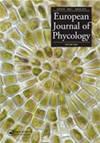从外果皮目到石斑藻目的菌毛转移及菌毛科的建议。nov.,和Ectocarpalales中Porterinema的分类
IF 1.7
4区 生物学
Q2 MARINE & FRESHWATER BIOLOGY
引用次数: 2
摘要
摘要基于叶绿体atpB、psaA、psbA、psb C和rbcL基因串联序列的分子系统发育研究表明,丝状褐藻Pilinia rimosa在系统发育上与Ectocarpales目相距甚远,已被归类为透明华藻(Waerniella lucifuga)。在该树中,Pilinia是由Ishiege和Petroderma(Ishieales)组成的分支的姐妹,具有较高的统计值。对原产于Helgoland(德国)、England(英国)、Woods Hole(美国)和Newfoundland(加拿大)的独眼轮虫培养物的观察表明,其生活史具有直接类型,通过特征性的单眼轮虫繁殖,通常只形成四种zoid。尽管Kuckuck的描述以及后来的出版物中都对多房性囊膜进行了描述,但我们得出的结论是,这些观察结果是基于对串联形成的非常小的单眼囊膜的误解,通常在囊膜之间有纵向壁。毛茛生长在岩石的洞穴或缝隙中,以及潮间带和喷雾带上部深阴处的墙壁或木桩上,因此被视为海洋物种,但它也可以在淡水介质中生存和成熟。我们建议为Pilinia建立一个新的科Piliniaceae,并将其放在石炭目中。对鉴定为宽盐藻Porterinema fluviatile的培养菌株SAG 124.79和SAG 2381的分子和形态学分析表明,SAG 124.75实际上是P.rimosa。然而,SAG 2381是真正的P.fluviatile,也显示出特征性的多室性zoidangia。Porterinema被证明是Chordariceae,Ectocarpales senso lato的一员。本文章由计算机程序翻译,如有差异,请以英文原文为准。
Transfer of Pilinia from Ectocarpales to Ishigeales (Phaeophyceae) with proposal of Piliniaceae fam. nov., and taxonomy of Porterinema in Ectocarpales
ABSTRACT Molecular phylogeny based on concatenated sequences of chloroplast atpB, psaA, psbA, psbC and rbcL genes indicates that the filamentous brown alga Pilinia rimosa is phylogenetically distant from the Ectocarpales, in which it has been classified (as Waerniella lucifuga). In the tree, Pilinia was sister to the clade comprised of Ishige and Petroderma (Ishigeales) supported by high statistical values. Observations of unialgal P. rimosa cultures originating from Helgoland (Germany), England (UK), Woods Hole (USA) and Newfoundland (Canada) showed a direct type of life history with reproduction by characteristic unilocular zoidangia typically forming only four zoids. Despite the description of plurilocular zoidangia in Kuckuck’s account as well as in later publications, we conclude that those observations were based on misinterpretation of the very small unilocular zoidangia formed in series, often with longitudinal walls between zoidangia. Pilinia rimosa grows in caves or crevices in rocks, and on walls or wood pilings in deep shade in the upper intertidal and spray zone, and is therefore regarded as a marine species, but it could also survive and mature in freshwater medium. We propose the establishment of a new family Piliniaceae for Pilinia and place it in Ishigeales. Molecular and morphological analysis of the culture strains, SAG 124.79 and SAG 2381, identified as the euryhaline alga Porterinema fluviatile, indicated that SAG 124.79 is in fact P. rimosa. However, SAG 2381 is true P. fluviatile, also displaying the characteristic plurilocular zoidangia. Porterinema was shown to be a member of the Chordariaceae, Ectocarpales sensu lato.
求助全文
通过发布文献求助,成功后即可免费获取论文全文。
去求助
来源期刊

European Journal of Phycology
生物-海洋与淡水生物学
CiteScore
4.80
自引率
4.20%
发文量
37
审稿时长
>12 weeks
期刊介绍:
The European Journal of Phycology is an important focus for the activities of algal researchers all over the world. The Editors-in-Chief are assisted by an international team of Associate Editors who are experts in the following fields: macroalgal ecology, microalgal ecology, physiology and biochemistry, cell biology, molecular biology, macroalgal and microalgal systematics, applied phycology and biotechnology. The European Journal of Phycology publishes papers on all aspects of algae, including cyanobacteria. Articles may be in the form of primary research papers and reviews of topical subjects.
The journal publishes high quality research and is well cited, with a consistently good Impact Factor.
 求助内容:
求助内容: 应助结果提醒方式:
应助结果提醒方式:


